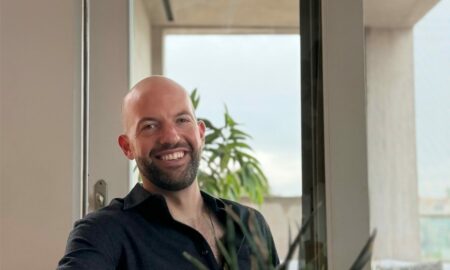Today we’d like to introduce you to David Gutierrez.
Alright, so thank you so much for sharing your story and insight with our readers. To kick things off, can you tell us a bit about how you got started?
My journey into the glass world started when I was picking my classes for fall of 2014. I chose five different studio art classes. At the time, I didn’t know I was committing art student suicide. But one of those was a glassblowing class. I struggled that whole semester with all those other classes, except for glassblowing. I took my first gather out of the school furnace that was raging at 2100 degrees and the bug instantly bit me. I was instantly enamored with the material; witnessing the physics of the material was something completely new to me. It was ferociously difficult. Keeping the glass on the rod, taking a good gather and all the while concentrating on keeping the glass centered and always turning. Soon after that, I realized that I was only going to get what I put into it and I wanted to see what I was personally capable of. So for the next five years, I feel like I lived in the hot shop at Cal-State Fullerton, every moment I could be there I was.
A short five months went by, I was on my 2nd semester of glassblowing had already received a scholarship to take a class with Jimmy Anderegg at Pilchuck glass school in Stanwood Washington. At the time, I had no idea what I was about to get myself into. I saw photos of the campus but was not ready for how beautiful the setting was, and I was not ready for how intense the class was. Jimmy showed us amazing glass techniques that I never knew existed and were as if he manipulated physics in a way no human could. At the end of the three weeks course, I was so burnt out. I never knew how intense professional glassblowers performed in the shop and gave me a reference point for the level of glassblower I wanted to do be.
While in school, I dreamed of becoming a professional glassblower. One day glassblowing extraordinaire Ethan Stern was giving a demonstration at my school’s hot shop and Kazuki Takizawa happened to attend. Up to that point I only knew his name I was familiar with his work, but I noticed this guy that looked like a rock star and I definitely knew he wasn’t a student there, so I took a chance introducing myself to him and we instantly got along. By the end of our conversation he invited me to come work for him at what is now his studio KT Glassworks. I jumped at the chance and worked for him later that week. Being there that day really showed me what it takes to become a glassblower. It was my first time blowing glass for a solid 8 hours and I was exhausted by the end of it. I had something to do the entire time whether it was cycling out glass pipes, waxing jacks, or being ready to blow into the blowpipe. That day not only showed me what I needed to strive for but also that I was capable to do it since Kazuki still wanted to work with me after that day. After graduating college, I quit my college job and started working as Kazuki’s main assistant since 2018. Since then, I have worked for various artists such as Kelly Akashi, Anthony Bianco and Kaj Akira. I have gained a lot of work experience thanks to them and have been able to gather an overwhelming amount of inspiration and support from them. Especially Kazuki, he has been such a supportive force in my life and can never thank him enough.
Alright, so let’s dig a little deeper into the story – has it been an easy path overall and if not, what were the challenges you’ve had to overcome?
There have been some bumpy roads along the way. The hardest one was and still is blowing glass! Its been such a journey learning how to tame this molten life force that could hurt me at any moment yet so drawn too. I feel glassblowing is like skateboarding, there is a certain trick one wants to pull off and will fall over and over till they nail the trick. In glassblowing people break things repeatedly, often at times when they spent hours or even days making it. Ive done that in spades, but that’s part of the process, failing and analyzing where you messed and then you perfect it. I feel I am still learning things about the material all the time.
Another obstacle for me was a personal struggle within myself to committing to being a practicing artist. Its something I didn’t know I was capable of being. In college I wasn’t confidant that I would be able to make a living through my art and talents. But I followed through with it, and I couldn’t be happier with where I am in my life.
Alright, so let’s switch gears a bit and talk business. What should we know about your work?
My favorite technique in glass blowing is making patterns which often involves glass canes. Glass cane is made through the process of placing solid glass color on the center of a rod and gathering layers of clear glass over it. One then stretches it to the width of a pencil. The result is a line of colored glass surrounded by clear glass. With the cane technique one can create intricate patterns such as Reticello, Zanfirco, Ballotini, and many more. Many patterns that stem from ancient Italian glass blowing techniques are featured in my work. I love creating these patterns and been known amongst my colleagues as a “cane guy”.
I am most proud of my undergraduate show, it has been my only solo show. I put everything I learned in college into that show from glassblowing to gallery design. My show was titled “Celestial Interval” and featured my interpretation of the Korean Moon Jar which represents virtue, modesty and purity therefore can be seen as a Celestial form. Meanwhile the show itself was only available for a certain interval of time in the given space. The show featured different moon jars placed in different metal structures, made by my father and myself, that imitated planets in orbit. All the moon jars boasted my most intricate cane and murrini patterns that I could muster at the time. I prepared for the show a whole year in advance and pushed the scale of my work as far as I could take it.
One of the things I feel sets me apart from others is being able to stay consistent in the hot shop by following the lead of the gaffer. Because I am able to take direction well and learn from my mistakes. I have been lucky enough to work on amazing glass blowing teams to create one of a kind works of art and have been able to take away a lot of experience from those moments. One example being working for Kelly Akashi has made me look in my bag of tricks any time we work together. She pushes the team with such unique ideas and has forced me to really think outside of the box on numerous occasions and those moments, when I have the answer, are what set me apart from people that would just say it isn’t possible with hot glass.
So, before we go, how can our readers or others connect or collaborate with you? How can they support you?
Anyone is welcome to reach out to me through Instagram @david_a_magnifico, I am very open to the idea of collaborating with other artists. Or they can come visit KT Glassworks and I am almost always there blowing glass or working on building guitars.
Pricing:
- Silver Sphere cup 50.00
- Gold Sphere cup 65.00
Contact Info:
- Email: [email protected]
- Instagram: https://www.instagram.com/david_a_magnifico/
Image Credits:
Deshon Tyau




















